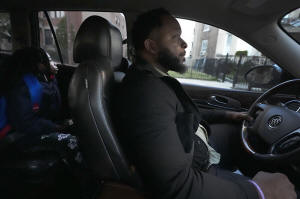As schools cut back on bus service, parents are turning to rideshare
apps
 Send a link to a friend
Send a link to a friend
 [December 16, 2024]
By JEFF McMURRAY [December 16, 2024]
By JEFF McMURRAY
CHICAGO (AP) — Ismael El-Amin was driving his daughter to school when a
chance encounter gave him an idea for a new way to carpool.
On the way across Chicago, El-Amin’s daughter spotted a classmate riding
with her own dad as they drove to their selective public school on the
city’s North Side. For 40 minutes, they rode along the same congested
highway.
“They’re waving to each other in the back. I’m looking at the dad. The
dad’s looking at me. And I was like, parents can definitely be a
resource to parents,” said El-Amin, who went on to found Piggyback
Network, a service parents can use to book rides for their children.
Reliance on school buses has been waning for years as districts struggle
to find drivers and more students attend schools far outside their
neighborhoods. As responsibility for transportation shifts to families,
the question of how to replace the traditional yellow bus has become an
urgent problem for some, and a spark for innovation.
State and local governments decide how widely to offer school bus
service. Lately, more have been cutting back. Only about 28% of U.S.
students take a school bus, according to a Federal Highway
Administration survey concluded early last year. That’s down from about
36% in 2017.
Chicago Public Schools, the nation’s fourth-largest district, has
significantly curbed bus service in recent years. It still offers rides
for disabled and homeless students, in line with a federal mandate, but
most families are on their own. Only 17,000 of the district’s 325,000
students are eligible for school bus rides.

Last week, the school system launched a pilot program allowing some
students who attend out-of-neighborhood magnet or selective-enrollment
schools to catch a bus at a nearby school’s “hub stop.” It aims to start
with rides for about 1,000 students by the end of the school year.
It’s not enough to make up for the lost service, said Erin Rose
Schubert, a volunteer for the CPS Parents for Buses advocacy group.
“The people who had the money and the privilege were able to figure out
other situations like rearranging their work schedules or public
transportation,” she said. “People who didn’t, some had to pull their
kids out of school.”
On Piggyback Network, parents can book a ride for their student online
with another parent traveling the same direction. Rides cost roughly 80
cents per mile and the drivers are compensated with credits to use for
their own kids’ rides.
“It’s an opportunity for kids to not be late to school,” 15-year-old
Takia Phillips said on a recent PiggyBack ride with El-Amin as the
driver.
The company has arranged a few hundred rides in its first year operating
in Chicago, and El-Amin has been contacting drivers for possible
expansion to Virginia, North Carolina and Texas. It is one of several
startups that have been filling the void.
Unlike Piggyback Network, which connects parents, HopSkipDrive contracts
directly with school districts to assist students without reliable
transportation. The company launched a decade ago in Los Angeles with
three mothers trying to coordinate school carpools and now supports some
600 school districts in 13 states.
Regulations keep it from operating in some states, including Kentucky,
where a group of Louisville students has been lobbying on its behalf to
change that.
After the district halted bus service to most traditional and magnet
schools, the student group known as The Real Young Prodigys wrote a
hip-hop song titled “Where My Bus At?” The song’s music video went viral
on YouTube with lyrics such as, “I’m a good kid. I stay in class, too.
Teachers want me to succeed, but I can’t get to school.”
[to top of second column]
|

PiggyBack Network co-founder & CEO Ismael El-Amin, right, and
Messiah Robinson, 6, wait outside the home of Takia Phillips, 15, on
Friday, Oct. 18, 2024, as El-Amin drives the two children to school
as part of the PiggyPack ride-share network in Chicago. (AP
Photo/Charles Rex Arbogast)

“Those bus driver shortages are not really going away,” HopSkipDrive
CEO Joanna McFarland said. “This is a structural change in the
industry we need to get serious about addressing.”
HopSkipDrive has been a welcome option for Reinya Gibson’s son,
Jerren Samuel, who attends a small high school in Oakland,
California. She said the school takes care to accommodate his needs
as a student with autism, but the district lined up the
transportation because there is no bus from their home in San
Leandro.
“Growing up, people used to talk about kids in the short yellow
buses. They were associated with a physical disability, and they
were teased or made fun of,” Gibson said. “Nobody knows this is
support for Jerren because he can’t take public transportation.”
Encouragement from his mother helped Jerren overcame his fear about
riding with a stranger to school.
“I felt really independent getting in that car,” he said.
Companies catering to kids claim to screen drivers more extensively,
checking their fingerprints and requiring them to have childcare or
parenting experience. Drivers and children are often given passwords
that must match, and parents can track a child’s whereabouts in real
time through the apps.
Kango, a competitor to HopSkipDrive in California and Arizona,
started as a free carpooling app similar to the PiggyBack Network
and now contracts with school districts. Drivers are paid more than
they would typically get for Uber or Lyft, but there are often more
requirements such as walking some students with disabilities into
school, Kango CEO Sara Schaer said.
“This is not just a curbside-to-curbside, three-minute situation,”
Schaer said. “You are responsible for getting that kid to and from
school. That’s not the same as transporting an adult or DoorDashing
somebody’s lunch or dinner.”
In Chicago, some families that have used Piggyback said they have
seen few alternatives.
Concerned about the city’s rising crime rate, retired police officer
Sabrina Beck never considered letting her son take the subway to
Whitney Young High School. Since she was driving him anyway, she
volunteered through PiggyBack also to drive a freshman who had
qualified for the selective magnet school but had no way to get
there.
“To have the opportunity to go and then to miss it because you don’t
have the transportation, that is so detrimental,” Beck said.
“Options like this are extremely important.”

After the bus route that took her two kids to elementary school was
canceled, Jazmine Dillard and other Chicago parents thought they had
convinced the school to move up the opening bell from 8:45 a.m. to
8:15 a.m., a more manageable time for her schedule. After that plan
was scrapped because the buses were needed elsewhere at that time,
Dillard turned to PiggyBack Network.
“We had to kind of pivot and find a way to make it to work on time
as well as get them to school on time,” she said.
All contents © copyright 2024 Associated Press. All rights reserved |